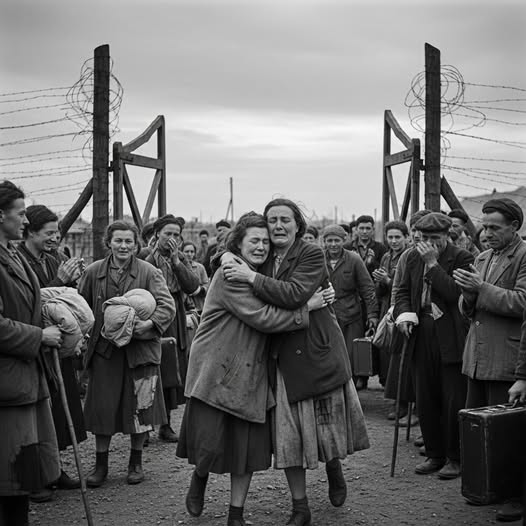The Mother at the Camp Gate – A Story of Reunion After the Holocaust
At the end of 1945, Europe rose from its ruins like a still-bleeding body. In the plains of Bavaria, the camps that had been built to imprison, humiliate, and destroy had been transformed, almost hastily, into detention centers for those who were now called displaced persons . But behind this administrative name were hidden shattered destinies, shattered families, nameless children, mothers without a grave to mourn. It was at the gates of one of these camps that a scene unfolded that few have dared to recount, but the memory of which still haunts witnesses.
The survivors arrived in waves, dressed in clothes donated by the Red Cross, their eyes clouded with disbelief. Every face seemed to hide a secret, every step echoing a past that could not be erased. The Allied guards stationed at the entrance tried to impose a semblance of order, but nothing could contain the burning tension of this improbable reunion. For each one, as they crossed that gate, carried in their hearts a question they dared not utter: Is someone still waiting for me?
It was there that a woman appeared, a gaunt figure, a headscarf ill-fitting over her thinning hair. She moved forward with an almost unreal determination, as if guided by an invisible force. For weeks, she had been roaming the camps, questioning, searching lists, refusing to give in to the evidence. She had been told that her daughter had last been seen inside a train heading east. She had also been told that she had to mourn, because at that age, few survived. But deep inside her, a thin thread still pulled at her, a thread that no wall or barbed wire had managed to break.
That morning, the gray light bathed the entrance to the camp, and in the crowd of newly arrived survivors, a flash of eyes struck her like a thunderclap. It was a teenage girl, dressed in a skirt that was too wide, her thin arms clutching a blanket. She seemed to hesitate, her gaze lost between hope and terror. The mother stopped, suffocated. At first, she thought she was dreaming, as she had dreamed of that face so many nights. But something in that look spoke the truth that the heart recognizes before reason.
Then, without warning, she screamed. A hoarse, broken cry that cut through the silence like a blade. Her daughter’s name burst from her lips, a name she hadn’t dared to say for months, for fear of hearing it disappear into the void. And in that suspended moment, the young girl looked up. Her body froze. She remained motionless for a moment, as if petrified by the fear that this vision was nothing more than a cruel mirage. Then suddenly, her legs began to run.
The embrace was violent, almost painful. They crushed against each other with a force that was as much rage as love. Tears gushed uncontrollably, and their sobs echoed beyond the barbed wire. The other survivors, crowded around the door, stopped. Some applauded, others wept. In this shattered world, everyone knew what this miracle meant: against all logic, a fragment of family had just been brought back to life.
But amidst the embraces, one question remained, hanging in the air: What about the others? For if a mother could find her daughter, how many thousands would remain unanswered, how many names would never be called, how many cries would go unheard? In the eyes of the spectators, there was joy, but also immense pain, that of knowing they were witnessing a happiness that would never belong to them.
The mother and daughter refused to let go. Around them, the crowd gradually dispersed, but they remained standing, embracing each other as if the separation could return at any moment. Later, they were led to a barracks converted into a dormitory, where makeshift beds housed blended families. Yet nothing could dispel the weight of the past. The daughter recounted little: a convoy, hunger, faces vanished into the smoke. She spoke in fragments, as if her very words were afraid of awakening what still slept within her.
The following night, witnesses said they heard the mother murmuring in her sleep, repeating over and over: I found you, I found you . But some added, in low voices, that she also seemed to be speaking to others, invisible voices, as if each reunion carried the shadow of the absent. In this Bavarian camp, the walls held back more than screams: they kept the secrets that no one dared to write.
Even today, this scene remains an enigma of memory. Was it really his daughter, or a teenager whose features merged with those she had lost? History does not say. What we do know is that through this gesture, through this embrace, an entire broken generation clung to the idea that after barbarity, love could be reborn.
The mother at the camp gate was not just a survivor. She was the face of all those who had searched, waited, prayed tirelessly. And in that embrace, whether truth or illusion, she offered the world a message that even ruins could not smother: love survives the flames of history.
Note: Some content was generated using AI tools (ChatGPT) and edited by the author for creativity and suitability for historical illustration purposes.



Leave a Reply